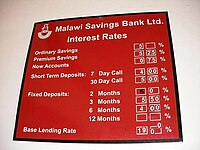
Photo from wikipedia
Abstract Most stated preference studies estimate discount rates using a split-sample approach. Each sample faces a different payment frequency (for instance, 1, 5, 10) together with a randomly assigned bid… Click to show full abstract
Abstract Most stated preference studies estimate discount rates using a split-sample approach. Each sample faces a different payment frequency (for instance, 1, 5, 10) together with a randomly assigned bid vector; both the frequency of payments and the bid are fixed for a specific individual. This paper evaluates whether allowing respondents to choose their preferred payment frequency affects the estimated discount rate. We use data from a contingent valuation survey of a network of marine reserves and estimate discount rates using both an exogenous and endogenous approach. The former calculates the mean of the willingness to pay (WTP) for each sample and then finds the discount rate that makes the present value of each payment frequency equivalent. The latter estimates the WTP and the discount rate jointly. Results show that allowing people to choose the payment schedule significantly reduces the implicit discount rate. We observed the highest reductions in discount rates when we used all the information available from the valuation questions to bound the WTP distribution. Our analysis suggests that the exogenous approach would not be recommended for testing the adequacy of people’s responses to the frequency of payments.
Journal Title: Journal of Environmental Economics and Management
Year Published: 2021
Link to full text (if available)
Share on Social Media: Sign Up to like & get
recommendations!